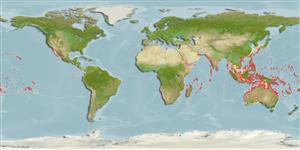Teleostei (teleosts) >
Blenniiformes (Blennies) >
Blenniidae (Combtooth blennies) > Salariinae
Etymology: Ecsenius: Greek, exenios, -os, -on = uncontrolled, immoderate.
Environment: milieu / climate zone / depth range / distribution range
Ecology
Marine; reef-associated; depth range 2 - 40 m (Ref. 30874). Tropical
Indo-Pacific: Gulf of Aqaba and southeast coast of Africa to the Marquesan Islands.
Size / Weight / Age
Maturity: Lm ? range ? - ? cm
Max length : 13.0 cm TL male/unsexed; (Ref. 2334)
Dorsal
spines
(total): 13 - 14;
Dorsal
soft rays
(total): 19-21;
Anal
spines: 2;
Anal
soft rays: 20 - 23. Golden orange in color; black spot around anus; anterior part of dorsal fin with narrow dark margin (Ref. 4404). Indonesian form grey or greenish to golden-yellow. Tail long in adults (Ref. 48636).
Adults inhabit coral reefs (Ref. 9710), from clear coastal to outer reef walls, usually where currents are moderate (Ref. 48636). They swim 2 to 3 m above the benthos, feeding on plankton (Ref. 94105). During the orange-yellow phase, they are observed to school with Pseudanthias squamipinnis which they resemble in color. Individuals of Ecsenius midas can change color quickly from when on the bottom to swimming in open water to match the colors of the fishes they mix with (Ref. 48636). They also socially mimic their swimming behavior and also of Pseudanthias huchtii and Lepidozygus tapeinosomoa (Ref. 90102). Reported to feed on zooplankton (Ref. 37816). Oviparous. Eggs are demersal and adhesive (Ref. 205), and are attached to the substrate via a filamentous, adhesive pad or pedestal (Ref. 94114). Larvae are planktonic, often found in shallow, coastal waters (Ref. 94114). Minimum depth reported taken from Ref. 9710.
Life cycle and mating behavior
Maturity | Reproduction | Spawning | Eggs | Fecundity | Larvae
Oviparous, distinct pairing (Ref. 205).
Springer, V.G., 1988. The Indo-Pacific blenniid fish genus Ecsenius. Smithson. Contrib. Zool. (465):134 p. (Ref. 5296)
IUCN Red List Status (Ref. 130435)
Threat to humans
Harmless
Human uses
Aquarium: commercial
More information
ReferencesAquacultureAquaculture profileStrainsGeneticsElectrophoresesHeritabilityDiseasesProcessingNutrientsMass conversion
Tools
Special reports
Download XML
Internet sources
Estimates based on models
Preferred temperature (Ref.
123201): 24.6 - 29, mean 27.7 °C (based on 716 cells).
Phylogenetic diversity index (Ref.
82804): PD
50 = 0.5000 [Uniqueness, from 0.5 = low to 2.0 = high].
Bayesian length-weight: a=0.00741 (0.00335 - 0.01640), b=3.02 (2.83 - 3.21), in cm total length, based on LWR estimates for this (Sub)family-body shape (Ref.
93245).
Trophic level (Ref.
69278): 2.6 ±0.29 se; based on food items.
Resilience (Ref.
120179): High, minimum population doubling time less than 15 months (Preliminary K or Fecundity.).
Fishing Vulnerability (Ref.
59153): Low vulnerability (10 of 100).
Nutrients (Ref.
124155): Calcium = 121 [60, 183] mg/100g; Iron = 0.735 [0.441, 1.221] mg/100g; Protein = 18.1 [17.0, 19.1] %; Omega3 = 0.0937 [, ] g/100g; Selenium = 28.6 [14.4, 58.5] μg/100g; VitaminA = 112 [34, 379] μg/100g; Zinc = 2.03 [1.38, 2.82] mg/100g (wet weight);
